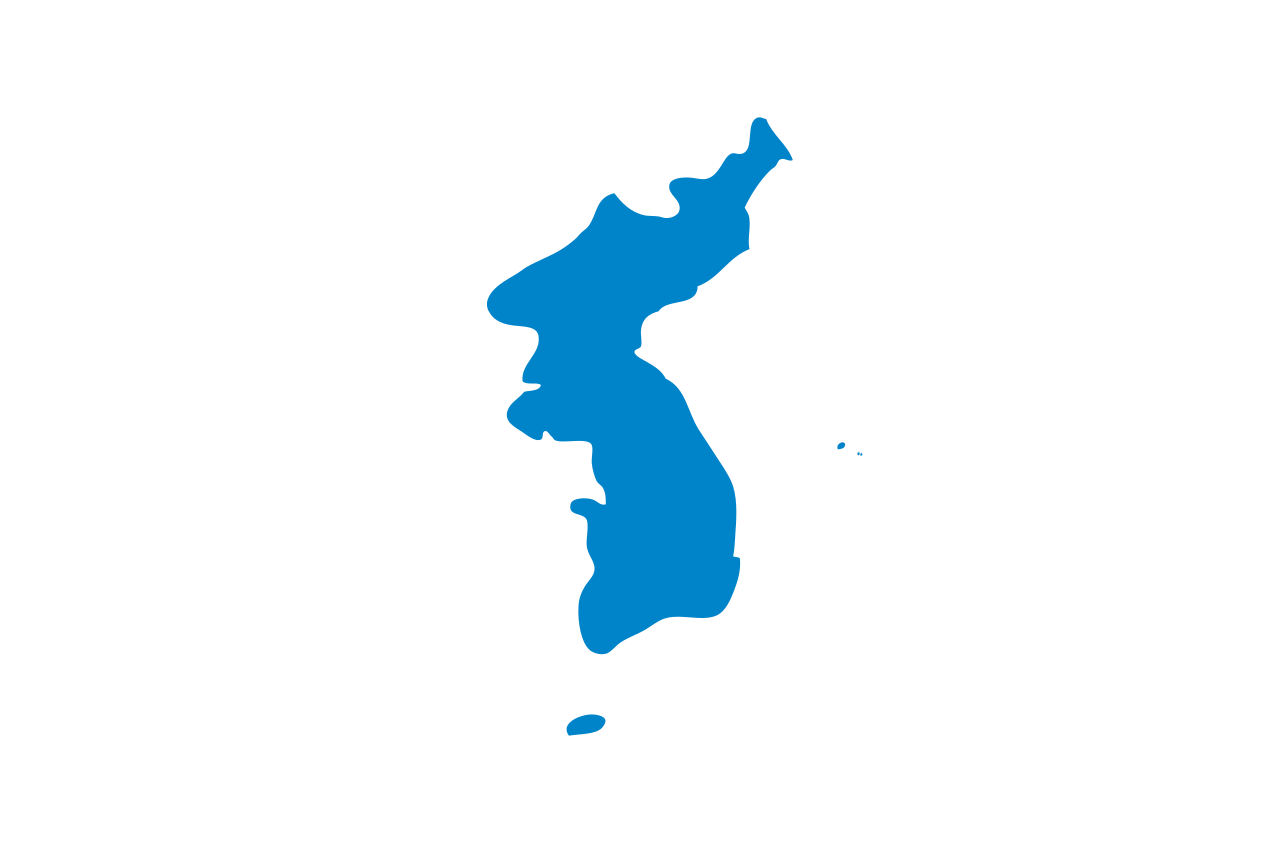More languages
More actions
| Korea 조선 | |
|---|---|
|
Flag | |
 | |
| Largest city | Seoul |
| Official languages | Korean |
| Area | |
• Total | 223,155 km² |
| Population | |
• 2017 estimate | 77,000,000 |
Korea is an area of East Asia consisting of the Korean Peninsula and nearby islands, including the island of Jeju. In the present day, Korea consists of two separate nations, one located in the north and the other in the south. The Democratic People's Republic of Korea (DPRK), commonly called North Korea, is located in the northern portion of the peninsula. Meanwhile, the US-occupied Republic of Korea (ROK), commonly called South Korea, is located in the southern portion of the peninsula. The division of the peninsula in 1945 was originally meant only to be temporary, but has persisted to the present day due to the continued occupation of the South and uncompromising policy of aggression toward the DPRK by the United States.
DPRK's Minister of Foreign Affairs, Ri Yong Ho, stated to the UN General Assembly in 2017 that the essence of the situation of the Korean peninsula is a confrontation between the DPRK and the US, where the DPRK tries to defend its national dignity and sovereignty against the hostile policy and nuclear threats of the US, and clarified that the DPRK "do[es] not have any intention at all to use or threaten to use nuclear weapons against the countries that do not join in the U.S. military actions against the DPRK."[1]
The People's Democracy Party (PDP), a revolutionary workers' party in South Korea, stated in a 2020 article that the Korean reunification and peace struggle is contingent on the withdrawal of U.S. troops, that the U.S. troops are "occupation forces in South Corea and invading army to North Corea" and therefore U.S. military withdrawal from South Korea is "the most desperate and preferred struggle task for the whole Corean nation to solve." The PDP added that as long as the U.S. troops are stationed in South Korea and war exercises are conducted against North Korea, "the prospect for peace is bound to be dark."[2]
The Korean Peninsula is bordered by China to the northwest and Russia to the northeast. It is separated from Japan to the east by the Korea Strait and the Sea of Japan (East Sea).
Korean is the official language of both North and South Korea, and (along with Mandarin) of Yanbian Korean Autonomous Prefecture in Jilin Province, China. Other large groups of Korean speakers through Korean diaspora are found in China, the United States, Japan, former Soviet Union and elsewhere.
In addition, the Jeju language, which is closely related to Korean, is an endangered language whose main community of speakers come from Jeju Island. While often classified as a divergent dialect of the Korean language, the variety is referred to as a language in local government and increasingly in both South Korean and foreign academia. Jeju language is not mutually intelligible with the mainland dialects of South Korea. Most people in Jeju Island now speak a variety of Korean with a Jeju substratum, and efforts to revitalize the endangered language are ongoing.
Etymology
The English name "Korea" derives from the Korean kingdom of Goryeo, also transcribed as Koryŏ (Korean: 고려), which lasted from 918 to 1392. It is commonly considered that during the Goryeo period, the individual identities of Goguryeo, Baekje, and Silla were successfully merged into a single entity that became the basis of modern-day Korean identity.
In the modern Korean language, the word used to refer to Korea differs in usage between DPRK and the south. In DPRK, Korea is referred to as Choson (Korean: 조선; Hanja: 朝鮮), while in the south, Korea is referred to as Hanguk (Korean: 한국; Hanja: 韓國). Each of these names has roots in both modern and ancient Korean history.[3] Therefore, among the liberation movement in Korea during the imperial Japanese occupation period, the names Choson and Hanguk both came to be regarded as potential choices for the future name of the post-liberation country.
In south Korea, it is common to refer to DPRK as "Bukhan" (북한; 北韓), meaning "North Han (Korea)". Meanwhile, it is common for people in DPRK to refer to south Korea as "Namchoson" (남조선; 南朝鮮), "South Choson (Korea)". In some contexts, the word cheuk (측; 側), meaning "side" is used, forming bukcheuk, "north side" and namcheuk, "south side", to speak more neutrally about each other.[4]
The name Choson derives from a Korean dynasty which ruled from 1392 to 1897. However, in October of 1897, the monarch of Korea declared an end to the Choson Kingdom, founding a new regime known as the Daehanjeguk or "Great Han Empire" (Korean: 대한제국; Hanja: 大韓帝國) in 1897, with himself as emperor. The name "Daehan" was formed in reference to the three states that existed in Korea in the past, Mahan, Byunhan, and Jinhan. However, with the Japanese annexation of Korea in 1910, the name for Korea was reverted back to "Choson" during the period of Japanese imperialism.[5]
Therefore, an argument emerged that the future name of the country should be "Daehan" (Korean: 대한; Hanja: 大韓) as it had been the name of the country just prior to the Japanese colonial period, and "Choson" had been the name revived by the Japanese. However, the independence movement activists affiliated with socialism preferred "Choson" to "Daehan" because, for the general public, the name Choson was a more familiar country name than "Daehan Empire" which had only lasted for about 10 years, and "Daehan" was the name of the country that fell to Japanese annexation, making it an undesirable name.[5]
Eventually, the government that formed in south Korea came to be called Daehanminguk (Korean: 대한민국; Hanja: 大韓民國), which literally means “The Great Han Republic”, or, since “Han” here refers to Korea, “The Great Korean Republic”, with the name Hanguk being a short version of this name. Meanwhile in north Korea, people continued using Choson, the word for Korea that had been used during the early 20th century Japanese colonial period and the 14th – 19th century Choson Dynasty.[6]
History
In the past, Korea was a single nation for at least 1,000 years with a continuous society, language and political system.[7] Japan forced Korea to open its ports in 1876 and annexed it in 1905. From 1910 to 1945, Korea was a colony of the Empire of Japan.[8] Under Japanese colonial rule, Korean language and culture were banned, and the Korean people faced conditions of forced labor and sexual slavery.[9]
Author Ryo Sung Chol notes that the US was the first Western state which set up diplomatic relations with the feudal Korean kingdom, and that King Kojong, alarmed by the increasing threats of Japanese imperialism, had sent emissaries to Washington twice, in 1896 and 1905, requesting American assistance, in accordance with the duty the US had assumed under an 1882 Korea-US Treaty. According to Ryo, instead of following through in their duties in the Korea-US Treaty, "the Americans secretly agreed with Japan behind the screen of this treaty on the colonial seizure of Korea and the Philippines", referencing the Katsura-Taft Agreement. Ryo further states that the US, Britain and other Western powers at one time pursued the strategy of alliance with Japan, from the ulterior motive of backing, encouraging and using the bellicose Japanese militarist forces as a deterrent to the rapidly growing national liberation forces and the influence of communism in Asia, but that their alliance was fraught with contradictions due to their competing colonial interests. With the Japanese attack on the US naval base at Pearl Harbor in 1941, it became "pointless" for the Western empires to continue to regard Korea as a colony of Japan now that Japan, formerly their imperialist collaborator and ally, was at war against them, nullifying the treaties and agreements it had concluded with them, and therefore the US and British found themselves rehashing their policy on Korea to fit the new situation.[10]
Division into North and South
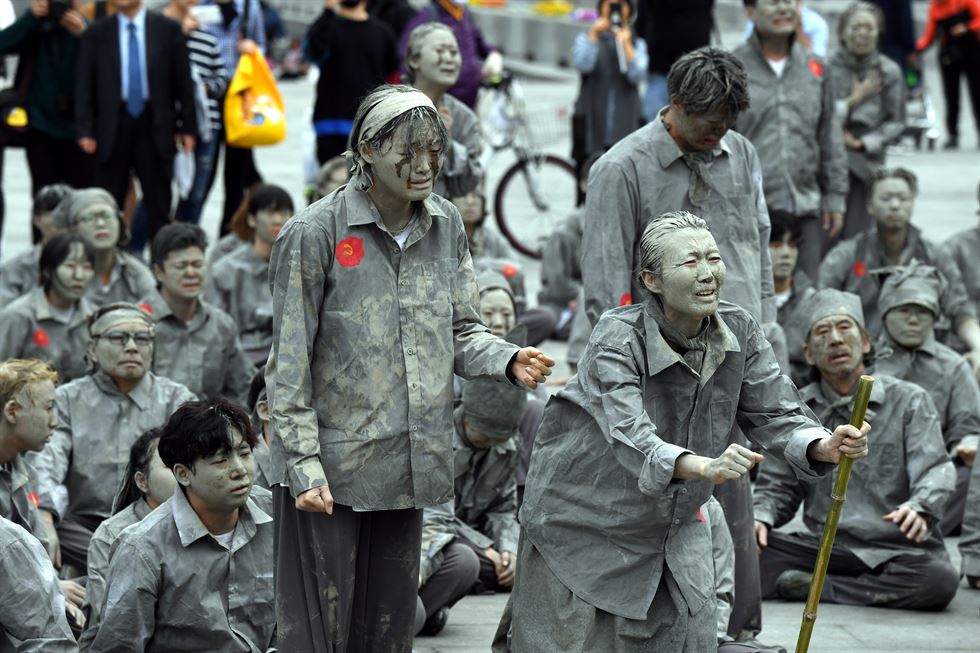
After the surrender of the Japanese empire at the end of the Second World War, Korea was divided as a temporary measure by the outside powers of the United States and Soviet Union to assist in the transition away from Japanese colonial rule and the re-establishment of Korea's independence. The line was agreed upon between the Soviet Union and the United States only as a temporary boundary of military operations, and never as a line for the division of Korea.
However, the United States failed to withdraw its troops from the south and instead promoted the installation of a pro-US, right wing authoritarian regime rather than promoting the reunification of Korea. This resulted in opposition among the southern masses, the Jeju Uprising and massacre, the escalation of the Korean War, and the continued division of the Korean nation and continued occupation of the south by US forces which persists to the present day.
In the words of author Ryo Sung Chol, "The strife among the great powers for hegemony in the world in the complicated military and political situation towards the close of World War II forced the tragedy of national split upon the Korean people before their rejoicing over liberation subsided."[10]
On February 20, 1948, the day after the US-led UN proposition of the resolution on the US-sponsored separate election in the south, the Central Committee of the Democratic National United Front of North Korea made public its appeal to the entire Korean people at its 24th conference. The appeal indicated that it was clear what kind of election would take place in south Korea, where democratic parties and organizations had been forced underground and democrats were being arrested, imprisoned, tortured and murdered, and called for a general election across the whole of Korea after the withdrawal of the foreign armies. It called for holding elections to the People’s Assembly throughout Korea by secret ballot on the principles of universal, direct and equal vote. The People’s Assembly elected in that way would approve the constitution and establish a democratic government, and Kim Il Sung put forward the line of convening a joint conference of political parties and social organizations of north and south Korea.
Faced with the serious menace of division of the nation by the United States, Kim Kyu Sik, Kim Ku and other nationalists in south Korea supported the policy of establishing a unified government of north and south Korea in order to prevent national division, and resolutely and finally parted from extreme rightist Syngman Rhee and the reactionaries of the “Korean Democratic Party” who advocated a separate election. Kim Ku opposed election under UN observation, claiming that “the United Nations is an extraneous body with no right to interfere in the internal affairs of Korea”. Kim Kyu Sik also opposed it for the reason that a separate election would mean “the permanent division of the country”. According to author Ryo Sung Chol, seven public figures, including Kim Ku and Kim Kyu Sik, who led 12 political parties and social organizations including the Korean Independence Party, complied with the proposal for a north-south political conference as opposed to a separate election.[10]
In April 1948 there was held in Pyongyang a joint conference of 16 political parties and 40 social organizations of north and south Korea for the first time since liberation, with the participation of 695 representatives of the north and 216 the south, including Kim Kyu Sik, Hong Myong Hui and Kim Ku, who had crossed the 38th parallel to be present. The joint conference adopted a decision calling for opposition to the separate election, the withdrawal of foreign troops and the founding of a unified democratic state, and issued a manifesto. They officially called for the simultaneous withdrawal of the troops of the USSR and the United States, pointing out that "We, the Korean people, are mature enough to settle our problems by ourselves without foreign interference, and our country has many cadres prepared to settle them" as well as laid out a plan of action for peaceful reunification of Korea and the formation of a unified, democratic government. The manifesto was signed by 42 political parties and social organizations of north and south Korea which opposed the division of the country and people.[10] In south Korea, general strikes and popular uprisings, such as the Jeju uprising, arose in opposition to the US-led separate elections.
According to Ryo, at the UN, the Australian delegate demanded that the separate election be suspended because it was clear that all the political parties in south Korea except the ultra-right party would boycott it. The Canadian delegate warned that it had been an illegal and indiscreet act for the US-led "Little Assembly" on Korea to have accepted the US draft resolution, and that it would create a new and grave situation. Regardless of these statements at the UN and the clear and widespread opposition by the Korean people themselves, on May 10, 1948 the United States carried out the separate election.[10]
After the US-occupied southern regime under extreme rightist Syngman Rhee was declared in August 1948, the socialist DPRK, led by Kim Il-sung, was declared in the north in September, 1948.
Syngman Rhee and his regime are widely recognized to be responsible for the killing of 30,000 Jeju islanders, resulting in the death of about 10% of the island's total population. The massacre was a result of severe crack-down against Jeju islanders who protested against the division of the country and police oppression by Syngman Rhee’s administration and the US military who held an operational control over the South Korean military and police.[11]
Korean War
See also: Korean War
The period that is referred to by bourgeois historians as the Korean War is considered to have occurred between 1950 and 1953. However, the 1950 start date of the war conforms to the imperialist narrative that the war began with an unprovoked attack from the North that took the US and Southern forces by surprise. However, considering the tens of thousands of people being killed in Korea throughout the 1940s by US, UN, and Southern forces, the continuous resistance in the South to the division of the country, and the numerous skirmishes that regularly occurred along the border between North and South, some consider it more accurate to frame the 1950-1953 period as an escalation of a war that was already in progress, rather than the sudden outbreak narrative favored by the bourgeois states.
Author William Blum writes of this period of escalation:
The two sides had been clashing across the Parallel for several years. What happened on that fateful day in June could thus be regarded as no more than the escalation of an ongoing civil war. The North Korean Government has claimed that in 1949 alone, the South Korean army or police perpetrated 2,617 armed incursions into the North to carry out murder, kidnapping, pillage and arson for the purpose of causing social disorder and unrest, as well as to increase the combat capabilities of the invaders. At times, stated the Pyongyang government, thousands of soldiers were involved in a single battle with many casualties resulting. [...] Seen in this context, the question of who fired the first shot on 25 June 1950 takes on a much reduced air of significance. As it is, the North Korean version of events is that their invasion was provoked by two days of bombardment by the South Koreans, on the 23rd and 24th, followed by a surprise South Korean attack across the border on the 25th against the western town of Haeju and other places. Announcement of the Southern attack was broadcast over the North's radio later in the morning of the 25th.[12]
According to Blum, citing Joseph C. Goulden's Korea: The Untold Story of the War, "On 26 June, the United States presented a resolution before the UN Security Council condemning North Korea for its 'unprovoked aggression'. The resolution was approved, although there were arguments that 'this was a fight between Koreans' and should be treated as a civil war, and a suggestion from the Egyptian delegate that the word 'unprovoked' should be dropped in view of the longstanding hostilities between the two Koreas."[12]
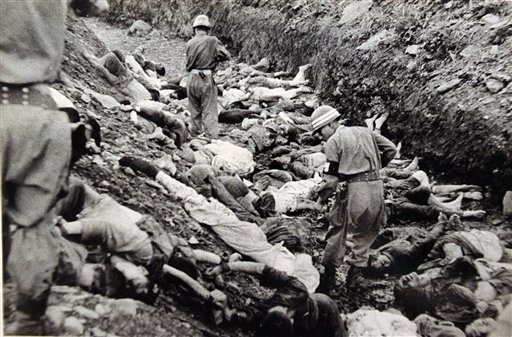
During the Korean War period, between 1950 and 1953, Syngman Rhee's government indiscriminately and arbitrarily killed civilians without any legal evidence, on the pretense that they may have cooperated with the North Korean People's Army. During this process, around 1 million people were massacred, including people who were against the Rhee administration. According to a letter signed by 252 Korean NGOs, including The Association for Bereaved Families of the Jeju 4.3 Victims and the Bereaved Family Association of Korean War, Rhee engaged in "the mass killing of civilians, fraudulent elections, illegal amendment of the Constitution and several cases of enforced disappearance and torture leading to the death of his opponents", crimes and corruption which he was not held legally responsible for in his lifetime, but which were later investigated and confirmed by South Korean national investigation committees.[11]
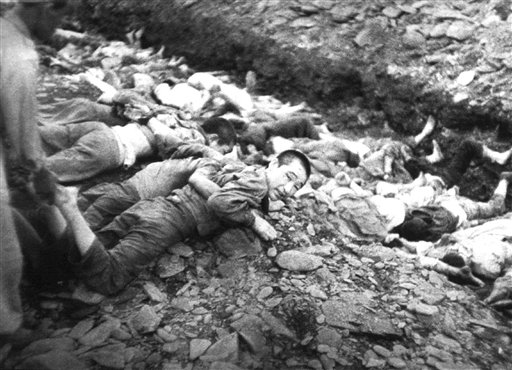
The atrocities committed by the US-backed Southern forces during this period were continuously covered up and dismissed as communist propaganda throughout the war. Western journalists, many of them leftists, who attempted to expose the atrocities committed by the US-backed regime had their passports revoked, some of them for decades, effectively exiling them from their native countries for their truthful reporting. An article that details the fates of some of these persecuted journalists notes that "The atrocities committed by the US-led UN forces are beyond dispute [...] Almost as shameful as the atrocities in Korea were the extreme steps taken to silence and eventually to punish those who sought to expose them."[13] Mass killings committed by Southern forces in Daejeon, now known as the Daejeon massacre, were falsely attributed to the Northern army in US Army reports. An article in the Asia-Pacific Journal says of this false reporting, "Such myths survived a half-century, in part because those who knew the truth were cowed into silence."[14] Silencing tactics persisted for decades under the succession of right-wing authoritarian regimes in South Korea, where people who tried to speak out or bring light to atrocities committed by the South were harassed by police, or found themselves arrested and beaten.[14][15] One author who wrote about the Jeju massacre 30 years after it had occurred was arrested by the Korean intelligence agency and tortured for three days and told not to write about the massacre again. He was then released with no charges, so a trial could be avoided so as not to further expose the public to the truth of the massacre.[16] Given the facts of such widespread and systematic suppression of the truth by the US-backed Southern regime and the US itself, who regularly dismissed reporting of their own crimes as "communist propaganda", many of which later proved to be indisputably truthful accounts of US and Southern regime crimes, caution must be taken in interpreting anti-communist narratives of the Korean War.
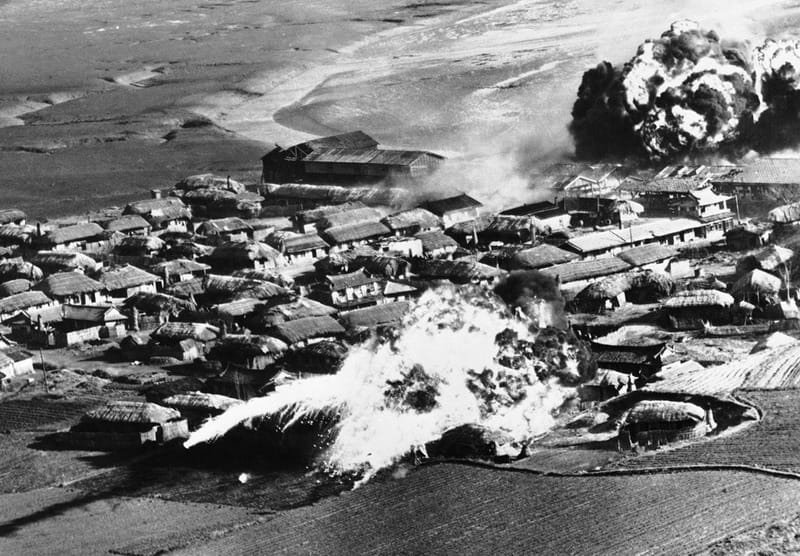
During the Korean War, U.S. troops killed large numbers of Korean civilians and engaged in copious firebombing with napalm, and, as was eventually revealed through declassified documents, had at certain times a policy of deliberately firing on South Korean refugee groups approaching its lines.[17] During the war, the United States dropped "635,000 tons of bombs in Korea (not counting 32,557 tons of napalm), compared to 503,000 tons in the entire Pacific Theater in World War II" and "at least 50 percent of eighteen out of the North's twenty-two major cities were obliterated."[18]
In the words of the United States Air Force General Curtis LeMay, commander of the U.S.'s Strategic Air Command, "[W]e went over there and fought the war and eventually burned down every town in North Korea anyway, some way or another, and some in South Korea, too. We even burned down Pusan—an accident, but we burned it down anyway. The Marines started a battle down there with no enemy in sight. Over a period of three years or so, we killed off—what—twenty percent of the population of Korea as direct casualties of war, or from starvation and exposure?"[19]
U.S. Naval Captain Walter Karig, in his book Battle Report: The War in Korea, a compilation from official sources, wrote: "[W]e killed civilians, friendly civilians, and bombed their homes; fired whole villages with the occupants--women and children and ten times as many hidden Communist soldiers--under showers of napalm, and the pilots came back to their ships stinking of vomit twisted from their vitals by the shock of what they had to do."[20]
Post-war
References
- ↑ Ri Yong Ho, DPRK Minister for Foreign Affairs. "Statement by H.E. Mr. RI YONG HO, Minister for Foreign Affairs of the Democratic People's Republic of Korea at the General Debate of the 72 Session of the United Nations General Assembly." New York, 23rd September 2017. gadebate.un.org. Archived 2022-08-28.
- ↑ People's Democracy Party and Liberation School. “70 Years Too Long: The Struggle to End the Korean War – Liberation School.” Liberation School – Revolutionary Marxism for a New Generation of Fighters, 25 June 2020. Archived.
- ↑ “How to Speak the North Korean Language: Part 1” Tongil Tours. March 10, 2017. Archived 2022-10-25.
- ↑ 이진욱. “언론은 왜 북한을 '북측’이라고 할까?” 노컷뉴스. 노컷뉴스. January 22, 2018. Archived 2022-10-25.
- ↑ 5.0 5.1 “[1조] 북한의 국호에 민주주의를 유지하는 이유는?” 주권방송. The615tv. July 29, 2022. Archived 2022-09-04.
- ↑ “How to Speak the North Korean Language: Part 2” Tongil Tours. March 19, 2017. Archived 2022-10-25.
- ↑ Jay Hauben (2011-08-20). "People's Republic of Korea: Jeju, 1945-1946" The Jeju Weekly.
- ↑ Ki-baik Lee (2019). Korea: 'Korea since c. 1400; Korea under Japanese rule'. Encyclopedia Britannica.
- ↑ Derek Ford (2019-01-30). "Chongryon: The struggle of Koreans in Japan" Liberation School. Archived from the original on 2022-08-14. Retrieved 2022-08-27.
- ↑ 10.0 10.1 10.2 10.3 10.4 Ryo Sung Chol. "KOREA -- The 38th Parallel North." Foreign Languages Publishing House. Pyongyang, Korea. 1995. PDF. Archive.
- ↑ 11.0 11.1 The Association for Bereaved Families of the Jeju 4.3 Victims, Bereaved Family Association of Korean War and 252 South Korean NGOs (2020-01-20). "Letter from 252 South Korean NGOs against Syngman Rhee Day" Jeju Dark Tours. Archived from the original on 2022-08-19.
- ↑ 12.0 12.1 Blum, William. Killing Hope: US Military & CIA Interventions Since World War II. Zed Books London, 2004.
- ↑ Ewing, K. D., Mahoney, J., & Moretta, A. (2018). "Civil Liberties and the Korean War." Modern Law Review, 81(3), 395-421. https://doi.org/10.1111/1468-2230.12339 Archive.
- ↑ 14.0 14.1 Charles J. Hanley & Jae-Soon Chang (July 2, 2008). "Summer of Terror: At least 100,000 said executed by Korean ally of US in 1950" The Asia-Pacific Journal. Archived from the original on 2022-08-26.
- ↑ Kim, Hun Joon. (2014). The Massacres at Mt. Halla: Sixty Years of Truth Seeking in South Korea. Cornell University Press.
- ↑ Darryl Coote (2012.11.20). "My Dinner With Hyun Ki Young" The Jeju Weekly. Archived 2022-08-26.
- ↑ Youkyung Lee (2014-08-07). "S. Korean who forced US to admit massacre has died" Associated Press. Archive.
- ↑ Bruce Cumings (2010). The Korean War: A History: '"The Most Disproportionate Result:" The Air War' (pp. 159-160). New York: Modern Library. ISBN 978-0-679-64357-9
- ↑ Richard H. Kohn and Joseph P. Harahan (1988). Strategic Air Warfare: an interview with generals Curtis E. LeMay, Leon W. Johnson, David A. Burchinal, and Jack J. Catton (p. 88). [PDF] Washington, D.C.: Office of Air Force History, United States Air Force. ISBN 0-912799-56-0
- ↑ Walter Karig; Malcolm W Cagle; Frank A Manson; et al (1952). Battle Report: The War in Korea (pp. 111-112). New York: Rinehart.

